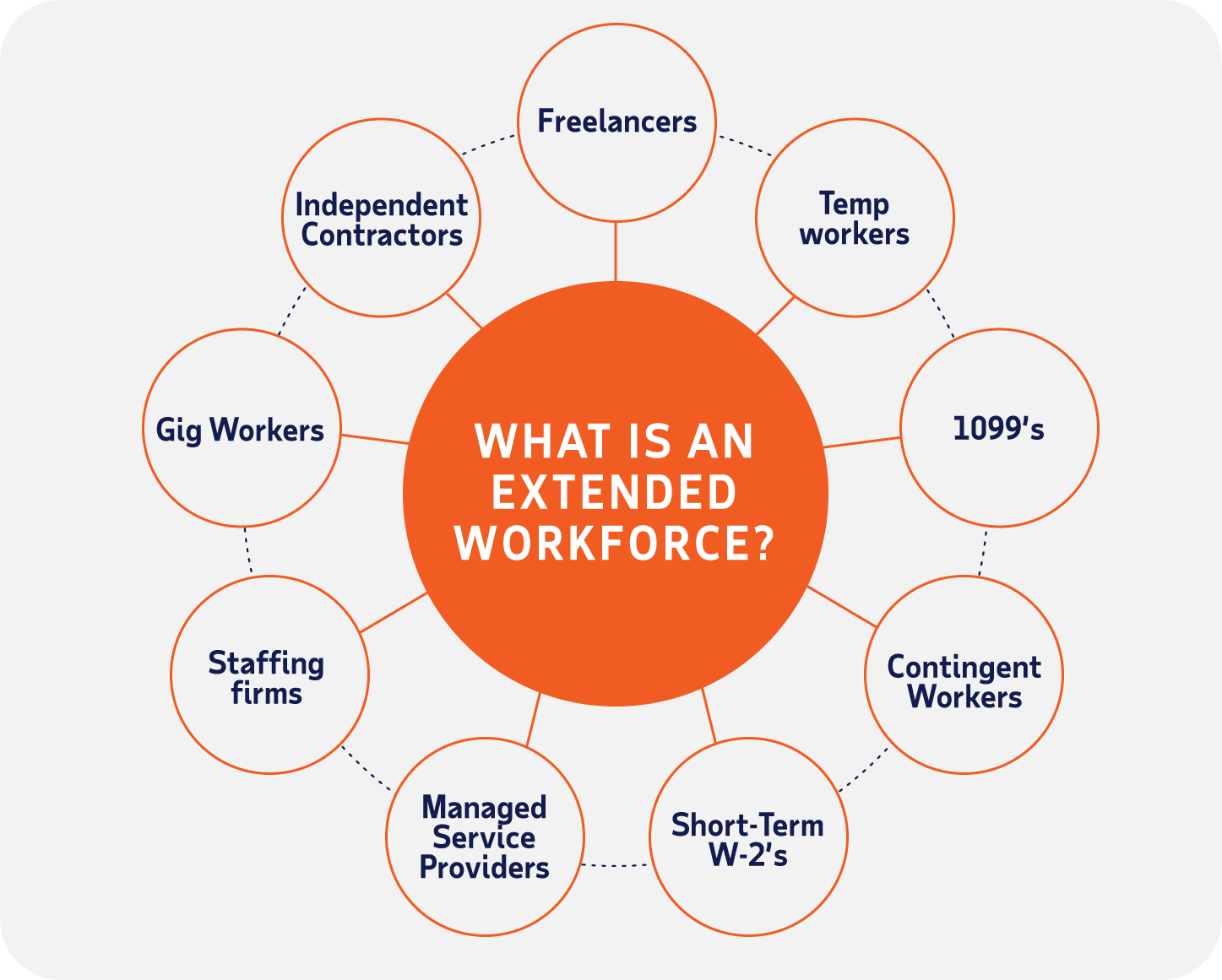Blog | 20 Nov 2020
Getting the most out of the gig economy

The use of contingent workers has been growing and is likely to remain high, driven in part by the impact of COVID-19. An increasingly competitive business landscape demands new ways of acquiring, diversifying, and retaining top talent—all of which are expected to become more critical in the wake of the pandemic.
Relying on contingent workers to fill gaps, meet project needs, and spearhead strategic change should result in performance improvements—if organizations manage these workers as part of their holistic talent strategy. One key to effective management is finding the right technology to track worker information, status, and performance. To work well, though, this technology must be part of a plan: companies should establish a clear strategy for engaging with non-payroll workers that considers everything from skills to cultural fit.
Leveraging the extended workforce
Fig. 1: What is an extended workforce?

Source: WorkMarket, an ADP Company
Organizations are engaging with the extended workforce to meet business needs as they arise, not just for routine tasks but also for specialized projects or strategic-level work. For example, Google looks beyond its considerable in-house expertise to deploy a range of contingent workers for certain roles and services. Other specialties are also in demand: to choose just some examples, architects, lawyers, graphic designers, and even mathematicians are increasingly contracted for their skills.
These types of work can be high in frequency and short in duration—for example, bringing in photographers to create content for new products, calling in repair specialists for office maintenance, working with photo-journalists on new stories, or collaborating with designers to complete the final stages of a deliverable.
|
Benefits to engaging with the extended workforce Flexibility and agility can be a matter of survival in an economic downturn. The extended workforce offers organizations the ability to contract short-term help for temporary issues. One trend we’re seeing as a result of the pandemic is that more organizations are completely restructuring their business models to account for an increase in contingent workers: a recent Gartner survey found that nearly one-third of organizations are replacing their full-time staff with contingent workers to save on costs. Skill sets and subject-matter expertise vary widely—and organizations often do not have what they need in-house. For small and large organizations alike, and across a range of industries, the skills needed to successfully run a business in its entirety are increasingly becoming varied and specialized; organizations must decide which skills are best kept and cultivated in-house, and which are best out-sourced for time and cost efficiency. Acknowledging the value their extended workforce provides, Microsoft announced they would continue to pay their hourly workers regular wages despite reduced services due to COVID-19 lockdown measures, listing a variety of independent contractors they rely on: café staff, shuttle drivers, and tech and audio-visual experts. Executing a new project does not happen overnight, and neither does building the team for it. Innovation is critical for organizations to stay relevant or assume leadership in a competitive market, but successfully implementing new ideas requires a significant amount of planning—and finding and retaining the right talent is a huge component of this process. And when nearly half of new hires fail within 18 months—largely due to an incompatible cultural fit—the talent search becomes vital. For example, organizations can test the need for new positions, skills, or expertise through the extended workforce before committing to permanence. These organizations might offer positions with a potential temporary-to-permanent path for those who are interested, essentially extending the interview phase to test how a worker fits within an organization’s culture and advances strategic goals before giving a full-time offer. |
Meeting the cultural criteria
Matching a contractor to a particular need makes for a productive engagement, but it should not be the only metric for success. A study of more than 5,000 hiring managers from public and private organizations conducted by Leadership IQ found that 46% of new hires fail due to a lack of soft skills such as motivation, emotional intelligence, temperament, and coachability; technical skills fared low on the list of reasons for failure. The same factors inevitably influence the performance of non-payroll workers.
While your contingent workforce relationships may be temporary and flexible, they are still investments that demand management in terms of time and resources. Screening prospective contingent workers for their soft skills can transform the way an organization engages with and benefits from its extended workforce, from improvements in work quality to increases in talent retention.
In many ways, it is up to the employer to ensure cultural fit with contract workers. Simple changes, like making sure contingent workers receive the same communication from management, are included where appropriate in the company’s social events, and are generally treated as valuable team members, can go a long way. To save time and resources, organizations can also be proactive in their search for culturally compatible talent: platforms such as freelance management systems allow organizations to automatically screen candidates for both technical and soft skills, for example through the use of customizable cultural fit assessments.
The rise in the contingent workforce is not slowing down any time soon. Treating all of your people like, well, people, is good management and good business in periods of both disruption and prosperity.
Oxford Economics produced this blog as part of a broader program with WorkMarket, an ADP company.
Tags:
You may be interested in

Post
Thriving beyond boundaries: Human performance in a boundaryless world
In collaboration with Deloitte, Oxford Economics surveyed 1,000 global executives and board leaders in order to understand their perspectives on emerging human capital issues.
Find Out More
Post
UK life sciences are set for growth, but challenges remain
The life sciences industry makes a major contribution to the UK economy. One in every 121 employed people in the UK works in the sector, which in 2023 contributed over £13 billion to the national economy.
Find Out More
Post
The Impact of the Longevity Workforce on the Resilience of Spain’s Economy
This study investigates how Spain’s ageing workforce should be seen as an antidote to financial shocks and an ingredient for future economic success.
Find Out More